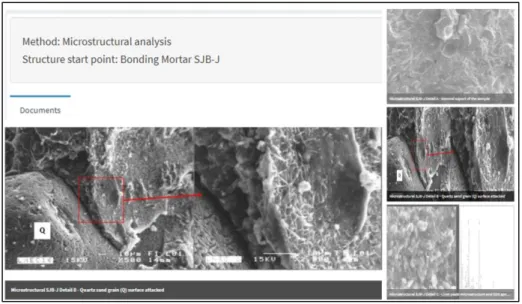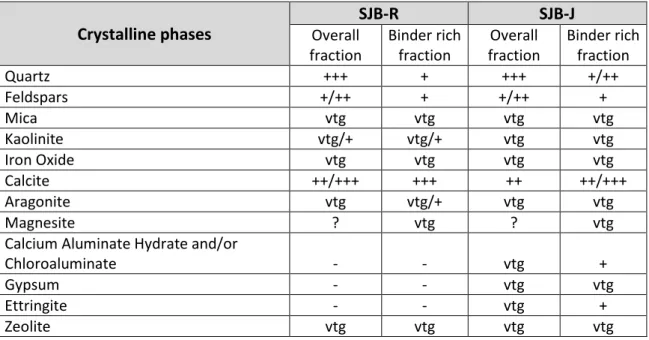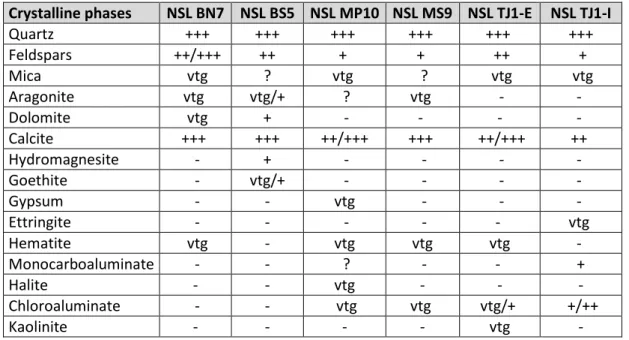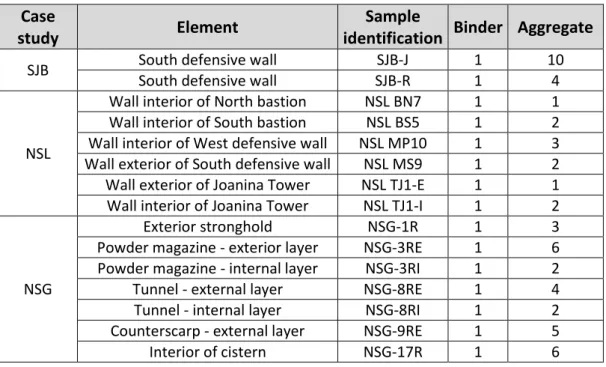DB-HERITAGE: A database of mortars composition and
characteristics
António Santos Silva1, Rodrigo Giollo2, Maria João Correia3, Maria do Rosário Veiga4, Paulina Faria5
(1) Materials Department, National Laboratory for Civil Engineering, Portugal, ssilva@lnec.pt
(2) Materials Department, National Laboratory for Civil Engineering, Portugal, rgiollo@lnec.pt (3) Materials Department, National Laboratory for Civil Engineering, Portugal, mjmcorreia@lnec.pt (4) Buildings Department, National Laboratory for Civil Engineering, Portugal, rveiga@lnec.pt
(5) CERIS and Civil Engineering Dep., FCT, NOVA University of Lisbon, Monte da Caparica, Portugal, mpr@ fct.unl.pt
Abstract
Mortars are materials which are present in constructions from the antiquity to nowadays, being complex in terms of their constituents and microstructure, incorporating traditions and techniques related to the local knowledge. Furthermore, the mortar characteristics vary also with its role in the structure and the place and environment of use.
The knowledge of the mortars constituents, characteristics and behaviour in their specific service conditions is important for improving the materials history and for a better definition of conservation strategies. That knowledge, obtained by many different researchers and practitioners of the area, should be easily available for all the professionals who need it, both for further research and for direct use in the field. This has been the background for the development of the DB-HERITAGE database project (http://dbheritage.lnec.pt/), which intends to build a repository for historical building materials, and a free-access IT-tool to collect the related data. This paper addresses specifically data from conservative interventions made on mortars applied on historic constructions. Additionally an overview of the database tools will be presented, exemplifying some of its outputs and potentialities related to historic mortars in different case studies in Portugal.
Keywords:
Introduction
Mortars are complex materials in terms of its constituents and microstructure, being in general influenced by local available raw materials, and also dependent of traditions and techniques that are used by the different countries and cultures. Similar to other materials, mortars have also had an evolution, which is closely linked to their roles and service environments, as well as to binders availability and production.
The study of mortars composition, their characteristics and behaviour in service conditions gives important information and data regarding their durability and history, which is necessary and important for materials improvement and for the definition of conservation strategies.
It is consensual that conservation and restoration in old buildings and monuments must respect the original materials, implying knowledge of the characteristics and functions of existing materials, as well as of their performance under service conditions [1]. Therefore, in the formulation of repair mortars, in addition to the characteristics of old mortars and substrates, the appropriate materials availability, the structure requirements and the exposure environment must be taken into account [2, 3]. The compatibility between materials will allow to maintain the old structure without causing harmful side effects, providing an effective protection. However, for this process to be successful, it is essential to record and preserve information on the characteristics of both old materials and those used in conservation and restoration interventions, as well as their positive or negative results.
That knowledge, obtained by many different researchers and practitioners of the area, should be easily available for all the professionals who need it, both for further research and for direct use in the field. In the last years there has been increasing global information on these topics, as well as on materials deterioration and ageing mechanisms.
This was, therefore, the framework for the creation of a digital infrastructure, designated DB-HERITAGE, to collect information on building materials with historical and heritage interest, and to provide different tools for documenting and preserving materials history, properties and performance. Mortars are one of the historical materials included in it, with a lot of information already collected.
This paper presents some of the potentialities available in this database (http://dbheritage.lnec.pt/), illustrated with some examples of mortars characteristics of Portuguese historic constructions.
DB-HERITAGE Database – General characteristics
The data which is being archived in the database consists of generic information on monuments/case studies, including reports, articles, photos and videos, historic overview of events (e.g. inspection, repair, conservation), including results of construction materials characterization by different analytical techniques, and the environmental characterization.
The user of the database can select specific monuments/case studies related data (e.g. generic information, historical events, material characterization) and access it according to different visualization options, including material type (e.g. mortar, stone, wood, etc.), and structure type (e.g. church, fort, palace, etc.) with option on filtering by case study designation (Figure 1).
Figure 1. Data query options in DB-HERITAGE database; in the map it is possible to see the location of the available case studies
The data for a given monument is hierarchically grouped according to its elements (e.g. tower, bastion, etc.) and components (e.g. interior wall, floor, etc.) - Figure 2.
Figure 2. Example of a hierarchical schematization of a case study
Environmental characterization data, namely meteorological and air pollution information, or soil and water characteristics, can also be included. The user may access the environmental information registered in the region where the monument is located or access the local registers associated with a related element or component of that monument.
The characterization data of each material is also grouped according to its nature in chemical, mineralogical, microstructural, physical or mechanical issues.
The events on each case study are subdivided into inspection, maintenance, monitoring and conservation/repair interventions. Each of these listed actions and detailed information can be accessed by the user. This information is synthesized in a dynamic framework that allows navigating to the materials characterization results by a given test method applied on a case study event.
The database provides the possibility of exporting data in different formats, and in the near future should allow data analysis, integrating some simplified analysis tools such as graphic representations and filters.
Historic mortars – Some features of the DB-HERITAGE database
To illustrate some of the functionalities of the database, examples of the characterization data of mortar samples from different case studies in Portugal are presented in the following sections.
Case studies
The Fort of São Julião da Barra (SJB), in Figure 3, is located on the right bank of the Tagus River, at the Point of São Gião. It is an example of military baroque architecture being
the most complete military defense complex constructed to defend the port of Lisbon. It was operational in 1580 but its construction took nearly a century to complete. Throughout Spanish dominion (1580–1640) it was used as a state prison. Latter, in 1650, works were undertaken to increase the power of the defensive landside. In the early 19th century, during the French occupation, Napoleon military forces were installed in São Julião da Barra to combat the English fleet that blocked the entrance of the Tagus river. The latest military action involving the fortress took place in the context of the 1831 Portuguese civil wars. Two samples, taken by the Portuguese Directorate-General for Cultural Heritage, one from the filling mortar (SBJ-J) and another from a rendering mortar (SJB-R), both from south wall [4], were characterized in terms of material constituents.
Figure 3. Aerial view of Fort of São Julião da Barra
The Fortress of Nossa Senhora da Luz (NSL), in Figure 4, is currently classified as a building of public interest, being located on the right bank of Tagus River, in Cascais Municipality. It is considered to be representative of the architecture transition from the medieval castle model to the bulwark fortress [5]. Built in 1580, in the Philippine period, it includes an earlier structure, the Santo António Tower, also known as Joanina Tower, ordered to be built by D. João II, in 1488, later transformed into a fortress with three Bastions, at the end of the 16th century, to reinforce the defense of the Bay of Cascais, constantly threatened by the English navy [6,7].
This fortress has a trace considered to be uncommon in Portuguese military architecture, a triangular plant with an interior courtyard that provides the connection between its three bastions and from where the stairs to the Joanina Tower and cisterns start. The two bastions face the sea form obtuse angles, while the third one forms an acute angle [6,7]. Due to the damages imposed by the Lisbon earthquake at 1755, part of the fortress and of the Joanina Tower have suffered important architectural transformations [5,6,7]. Currently, the fortress belongs to Cascais Municipality, and undergoes a process of recovery and revitalization with the purpose of implementing a museum space [7]. In 2012 a study was carried out on the characterization of the exterior and interior plasters of the fortress, aiming: (i) the in-situ evaluation of the state of conservation of the mortars; (ii) extraction of samples of the external and internal renders (labelled as NSL) for laboratory characterization.
Figure 4. Bulwark of Fortress Nossa Senhora da Luz
The Fort of Nossa Senhora da Graça (NSG), also known as Fort Count of Lippe (Figure 5), classified as National Heritage Site in 2010, and World Heritage Site by UNESCO in 2012, located in a mountain in the north of the town of Elvas, was built in the late 18th century ordered by King Joseph I of Portugal and by his minister, the Marquis of Pombal [8]. It is a masterwork of the 18th century military architecture, and is considered one of the greatest symbols of the bulwark fortresses of the world. The central structure is a 150 meters side quadrangle with pentagonal bastions at corners. Four ravelins cover the curtain wall, one of which constitutes the monumental entry. The central part of the bastioned structure features an octagonal stronghold with two floors and a parapet with gun ports. The fort´s octagonal tower has two vaulted floors. The first floor features a cross plant and includes a chapel in one of the cross´s arms. The second floor is divided in several compartments including gun ports, kitchens and wards. Below the stronghold, carved into the rock, there is a cistern. The stronghold is surmounted by de Governor´s House, also divided in two floors. In the external side, the structure is completed by a hornwork, a fifth ravelin and a wide dry moat [8,9].
As part of nomination by UNESCO, a conservation and restoration plan was implemented in 2015, involving a detailed characterization of materials used on fort´s construction. For this, several render samples (named NSG) were collected and tested in laboratory. The conservation and restoration works of mortars were carried out with compatible repair materials, selected according to the physical-chemical characterization study and their degradation state [8].
Figure 5. Aerial view of Fort of Nossa Senhora da Graça [10] Results of mortars characterization
The mortar samples were collected in elements that were considered representative of the environmental conditions in each case study. Their selection is in agreement with the methodology used by the National Laboratory for Civil Engineering (LNEC) to characterize mortars of ancient buildings and takes into account the importance of the different areas in terms of archaeological survey, techniques and materials. The characterization techniques used include: X-ray diffraction analysis (XRD), simultaneous thermogravimetric and differential thermal analysis (TGA-DTA), scanning electron microscopy with X-ray microanalysis (SEM/EDS), grain size analysis, wet chemical analysis, water absorption capillarity coefficient and compressive strength.
In the following sections examples of the results obtained will be presented showing some of the outputs generated by the database.
Figure 6 shows an example of an event, including its type, a brief description and the date. Two samples of S. Julião da Barra Fort, SJB_J from a masonry mortar and SJB_R from the external render are exemplified. A list of the test methods applied on a given sample is available in the database. The respective measurements can be accessed in the “details” column, or filtered by the method used. The tool also provides a search field and the possibility of exporting the concerned information in different formats.
Figure 6. List of the test-methods used for mortars characterization of Fort São Julião da Barra
Figure 7 gives an example of the microstructural analysis data related to the SJB-J sample. In the right hand column the user can select the associated information, which in this example includes several SEM images and an EDS spectrum. In the main frame, the elected image is detailed. This example concerns an aggregate/paste interface where a neoformation product on a quartz grain surface is visible.
Figure 7. Example of the data regarding the microstructural characterization results of the SJB-J sample
The available information on the database allowed downloading the data included in the following tables of analysis.
XRD composition
Tables 1 to 3 summarizes the XRD composition obtained for the analysed samples. The results show the analysis of two fractions: an overall fraction and a binder rich fraction. This allows to obtain a deeper information on neoformation products formed, as well as on degradation products present in the mortars.
Table 1. XRD composition of mortar samples from SJB
Crystalline phases SJB-R SJB-J Overall fraction Binder rich fraction Overall fraction Binder rich fraction Quartz +++ + +++ +/++ Feldspars +/++ + +/++ + Mica vtg vtg vtg vtg Kaolinite vtg/+ vtg/+ vtg vtg Iron Oxide vtg vtg vtg vtg Calcite ++/+++ +++ ++ ++/+++ Aragonite vtg vtg/+ vtg vtg Magnesite ? vtg ? vtg
Calcium Aluminate Hydrate and/or
Chloroaluminate - - vtg +
Gypsum - - vtg vtg
Ettringite - - vtg +
Zeolite vtg vtg vtg vtg
Notation: +++ abundant; ++ present; + small amount; vtg traces; ? doubts in presence; - undetected SJB samples: The rendering mortar, consisting essentially of sand minerals (quartz, feldspar, mica and kaolinite) and calcite, is characteristic of an air lime mortar with siliceous aggregates. The presence of magnesite and aragonite is attributed to the action of an environment rich in magnesium ions, such as seawater, that promotes the dissolution of calcite and its subsequent recrystallization in the form of aragonite and also cation exchange reactions between Ca2+ and Mg2+ in calcium carbonates to form magnesite. On the other hand, the masonry mortar sample presents also a mineralogical composition characteristic of an air lime mortar, although the proportion of calcite is lower than in the rendering mortar sample. The type of sand minerals identified in the masonry mortar is very similar to that of the render mortar sample. An interesting feature in both samples is the identification of a zeolite-type compound, with a composition similar to a hydrated sodium and calcium aluminosilicate, attributed to the development of pozzolanic reactions in these mortars of the calcium hydroxide of the air lime with some altered minerals present in the sand grains.
Table 2. XRD composition of mortar samples (overall fractions) from NSL
Crystalline phases NSL BN7 NSL BS5 NSL MP10 NSL MS9 NSL TJ1-E NSL TJ1-I
Quartz +++ +++ +++ +++ +++ +++ Feldspars ++/+++ ++ + + ++ + Mica vtg ? vtg ? vtg vtg Aragonite vtg vtg/+ ? vtg - - Dolomite vtg + - - - - Calcite +++ +++ ++/+++ +++ ++/+++ ++ Hydromagnesite - + - - - - Goethite - vtg/+ - - - - Gypsum - - vtg - - - Ettringite - - - - - vtg Hematite vtg - vtg vtg vtg - Monocarboaluminate - - ? - - + Halite - - vtg - - - Chloroaluminate - - vtg vtg vtg/+ +/++ Kaolinite - - - - vtg -
Notation: +++ abundant; ++ present; + small amount; vtg traces; ? doubts in presence; - undetected NSL samples: Mortars of Nossa Senhora da Luz Fort are relatively similar regarding the type of binder, which is a calcitic air lime, except NSL-BS5 sample that is a dolomitic lime, and possibly related to a restoration campaign. Also, the type of sand is similar, being siliceous. In samples of bulwarks (MP10 and MS9) and of the Torre Joanina (TJ1) some hydrated calcium aluminates (carbo and chloro) where identified, probably resulting from pozzolanic reactions between the aggregates and the lime, favored by the high moisture content in the environment around this Fort. In another masonry mortar the presence of sodalite and cristobalite compounds was detected, attributed to the employed sands, that may explain the the hydrated calcium aluminates found in most of the NSL mortar samples.
Table 3. XRD composition of mortar samples (overall fractions) from NSG
Crystalline phases NSG-1R NSG-3RE NSG-3RI NSG-8RE NSG-8RI NSG-9RE NSG-17R
Quartz ++/+++ +++ ++ +++ +/++ ++ ++ Feldspars ++/+++ +++ ++ ++ ++ ++ +/++ Mica + + Vtg vtg vtg vtg/+ vtg/+ Clinochlore - - - - vtg vtg - Kaolinite vtg vtg/+ ? vtg ? - + Amphiboles +/++ vtg/+ + vtg +/++ vtg/+ ++ Talc vtg vtg Vtg ? vtg ? vtg Calcite ++ +/++ ++/+++ +/++ ++ ++ +/++ Dolomite vtg vtg vtg vtg - - vtg
Calcium aluminate hydrate ? ? vtg vtg ?/vtg vtg vtg/+
Hydromagnesite - - - - vtg - -
Magnesite - - - vtg - - -
NSG samples: The rendering mortars consist of air lime and sands, which appear to be from igneous and metamorphic rocks given the type of minerals present (quartz, feldspars, mica, amphibole, chlorite and talc). Lime is of dolomitic nature, since in the binder rich fraction hydromagnesite and magnesite compounds are always present. Some of the mortars present in their composition calcium aluminate hydrates, which are associated to the reaction of certain alumina rich minerals of the aggregates (e.g. feldspars, mica) with the lime.
Binder/aggregate ratio
Table 4 presents the results of the binder/aggregate ratio (b/a) for the samples of the three case studies. The b/a values (weight ratios) obtained are very diversified, varying from 1:1 to 1:10, with an average of 1:3.5. This high variability, even within the same structure, suggests that the proportions binder/aggregate were not defined in advance. Apparently, the mixes were made in situ, probably according to workability, plasticity, bond, and in general the “hand” of the worker.
Table 4. Binder/aggregate weight ratios obtained for samples from SJB, NSL and NSG case studies
Case
study Element
Sample
identification Binder Aggregate
SJB South defensive wall SJB-J 1 10
South defensive wall SJB-R 1 4
NSL
Wall interior of North bastion NSL BN7 1 1 Wall interior of South bastion NSL BS5 1 2 Wall interior of West defensive wall NSL MP10 1 3 Wall exterior of South defensive wall NSL MS9 1 2 Wall exterior of Joanina Tower NSL TJ1-E 1 1 Wall interior of Joanina Tower NSL TJ1-I 1 2
NSG
Exterior stronghold NSG-1R 1 3
Powder magazine - exterior layer NSG-3RE 1 6 Powder magazine - internal layer NSG-3RI 1 2 Tunnel - external layer NSG-8RE 1 4 Tunnel - internal layer NSG-8RI 1 2 Counterscarp - external layer NSG-9RE 1 5
Interior of cistern NSG-17R 1 6
Physical and mechanical characteristics
Due to difficulties found in the physical and mechanical characterization of some samples collected in the case studies, such as irregular shape, small size and low cohesion, standard test methods cannot be directly applied, and it is necessary to make use of adaptations of existing laboratory test methods and to validate the results. In this sense, LNEC has been developing and validating some test methods to evaluate the
water absorption by capillarity, the drying capacity, the modulus of elasticity by ultrasound pulse velocity and the compressive strength.
The results obtained are evaluated by comparison with reference values. Thus, together with the other tests to which the samples are subjected, it is also possible to evaluate, from the point of view of their mechanical characteristics and behaviour to the water, the level of degradation of the building and its possible interventions needs.
The capillarity coefficient by contact (Ccc), the compressive strength by the confinement mortar method (Sccm) and ultrasonic velocity to calculate the dynamic modulus of elasticity (E), determined for some mortar samples from the case studies, are presented in Table 5.
Table 5. Physical and mechanical results for some mortar samples from SJB, NSL and NSG case studies Case study Sample identification 𝑪𝒄𝒄𝟓 [𝑲𝒈/(𝒎𝟐. 𝒎𝒊𝒏𝟎.𝟓)] [𝑵/𝒎𝒎𝑺𝑪𝒄𝒎 𝟐] [𝑵/𝒎𝒎E 𝟐] NSL NSL BN7 0.45 0.26 2895 NSL BS5 2.73 1.4 1380 NSL MP10 1.26 2.9 2960 NSL MS9 1.92 2.0 3530 NSL TJ1-E 0.98 3.7 2870 NSL TJ1-I 3.83 n.d. 2750 NSG NSG-1R 0.3 1.6 n.d. NSG-3RE 0.9 4.0 n.d. NSG-8RE 2.2 n.d. n.d. NSG-8RI 5.5 n.d. n.d. NSG-9RE 1.3 1.1 n.d. NSG-17R 1.6 1.1 n.d. n.d. – not determined
As shown, the values of physical and mechanical properties do not always present a good correlation with the values of binder/aggregate ratio. In fact the physical and mechanical characteristics of air lime mortars are related with their microstructure [11], which depends not only on the binder/aggregate ratio but mainly on the grain size distribution, nature and shape of the aggregate that condition the bond between the particles. The interrelation of matrix and aggregate define the pore structure, which greatly influence the carbonation rate, together with the environment conditions. On the other hand, some inverse correlation can be found between compressive strength and capillary coefficient. For example, for NSL samples, with the exception of NSL BN7, the lowest Ccc5 (0.98) corresponds to the highest Sccm (3.7), while the highest Ccc5 (2.73) is found for the sample with the lowest Sccm (1.4). In fact both properties are influenced by the pore structure.
The formation of some hydraulic compounds, such as carbo and chloroaluminate, as found in NSL MP10 and NSL TJ1-E may also contribute for increased mechanical strength and reduced water absorption rate.
Besides the mortars characteristics of the case studies presented in this paper, the database contains complete information on various other building materials and heritage referential structures and will have its potential maximized as it receives new case studies and gains new functionalities. Therefore, their contribution to the preservation of the built heritage will also increase.
Conclusions
The study of materials of historical constructions, especially of mortars, allows obtaining very relevant information about the history of the monument itself, but also on the performance of the material in the exposure conditions to which it was subjected. This information, when used in contrast to the same or other similar monuments or case studies, facilitates the decision in terms of the materials and compositions to be used in conservation and restoration interventions.
The developed database of building materials allows collecting the existing dispersed information and its assessment to respond to the needs of the conservation of the built heritage. In addition to the information on the performance of materials, it is possible relating it with other data such as meteorological data. Bibliographical information about a particular case study is also freely available. Simultaneously, it potentiates research to fill some identified knowledge gaps. This tool will continue to be expanded and developed in order to be indexed and queried by WHERE, WHEN and WHAT on a European cloud (ARIADNEplus).
Acknowledgments
The authors acknowledge the support of Fundação para a Ciência e Tecnologia (FCT), Portugal, for funding the research project PTDC/EPH-PAT/4684/2014: DB-Heritage - Database of building materials with historical and heritage interest.
References
1. Veiga MR, Aguiar J, Santos Silva A, Carvalho F (2001) Methodologies for characterisation and repair of mortars of ancient buildings. Proceedings of the 3rd International Seminar Historical Constructions, Guimarães, Universidade do Minho, pp. 353-362.
2. Riccardi M, Lezzerini M, Caro F, Franzini M, Messoga B (2007) Microtextural and microchemical studies of hydraulic ancient mortars: Two analytical approaches to
understand pre-industrial technology processes. Journal of Cultural Heritage. 8, pp. 350-360
3. Veiga MR (2012) Conservation of Historic Renders and Plasters: From Laboratory to Site. In: Válek J, Hughes J, Groot C (eds) Historic Mortars. RILEM Bookseries, vol 7. Springer, Dordrecht, pp 207-225.
4. Santos Silva A, Cruz T, Paiva MJ, Adriano P, Candeias A, Schiavon N, Mirão J (2011) Mineralogical and chemical characterization of historical mortars from military fortifications in Lisbon harbour (Portugal), Environmental Earth Sciences, 63 (7), 2011, pp. 1641-1650
5. Ramalho MM, Barro MF, Boiça J (2001) As fortificações marítimas da costa de Cascais, Quetzal, Cascais.
6. Website consulted: http://www.patrimoniocultural.gov.pt/pt/. Accessed 10 April 2019.
7. Veiga MR, Santos Silva A, Tavares M, Santos AR, Lampreia N (2013) Characterization of renders and plasters from a 16th Century Portuguese Military Structure: Chronology and durability. In Restoration of Buildings and Monuments, Vol. 19, n.4, 2013. pp. 223–238.
8. Santos Silva A, Santos AR, Veiga MR, Llera F (2016) Characterization of Mortars from the Fort of Nossa Senhora da Graça, Elvas (Portugal) to support the conservation of the monument. In: HMC2016 - 4th Historic Mortars Conference, Santorini, Greece, pp. 42-49. ISBN: 978-960-99922-3-7.
9. Guerra S (2008) O Forte de Nossa Senhora da Graça, Monumentos, n.º 28, pp. 44-51.
10. In situ Lda. (2015) Conservation Plan. Aerial view.
11. Santos AR, Veiga MR, Santos Silva A, Brito J, Alvarez JI (2018) Evolution of the microstructure of lime based mortars and influence on the mechanical behaviour: The role of the aggregates. Construction and Building Materials, Vol. 187, pp. 907–922.
SANTOS SILVA A., GIOLLO R., CORREIA M.J., VEIGA M.R., FARIA P. (2019), DB-HERITAGE: A database of mortars composition and characteristics. HMC2019 - 5th Historic Mortars Conference, 19-21 June
2019, Pamplona. RILEM Proceeedings PRO 130, José Ignacio Álvarez, José María Fernández, Íñigo Navarro, Adrián Durán, Rafael Sirera (Eds.), ISBN: 978-2-35158-221-3, e-ISBN: 978-2-35158-222-0,
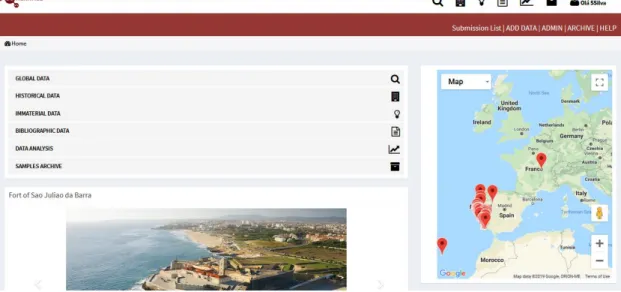
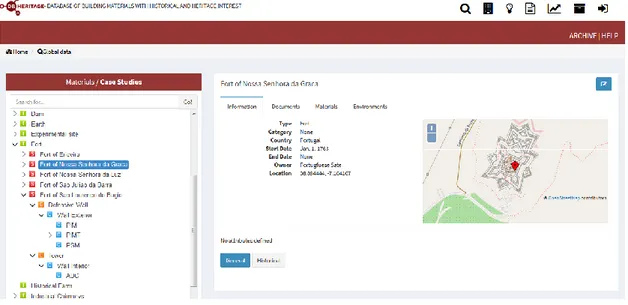
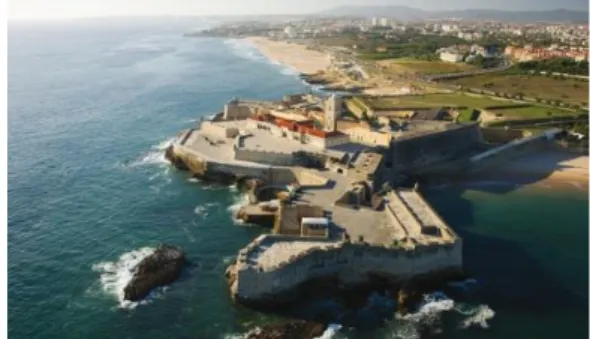
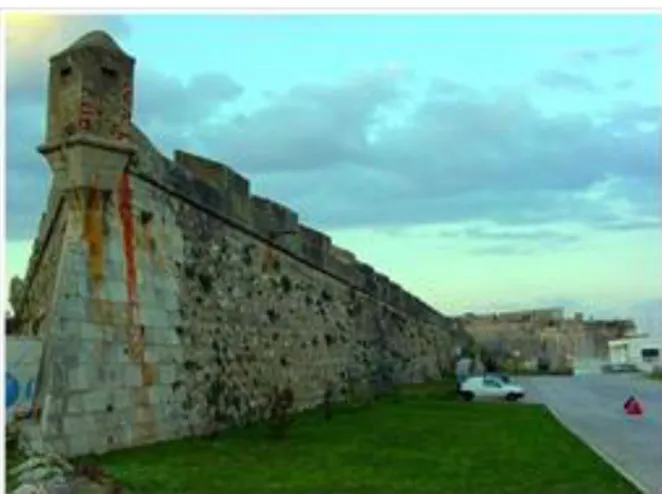
![Figure 5. Aerial view of Fort of Nossa Senhora da Graça [10]](https://thumb-eu.123doks.com/thumbv2/123dok_br/19219921.962229/7.892.273.622.105.330/figure-aerial-view-of-fort-nossa-senhora-graça.webp)
